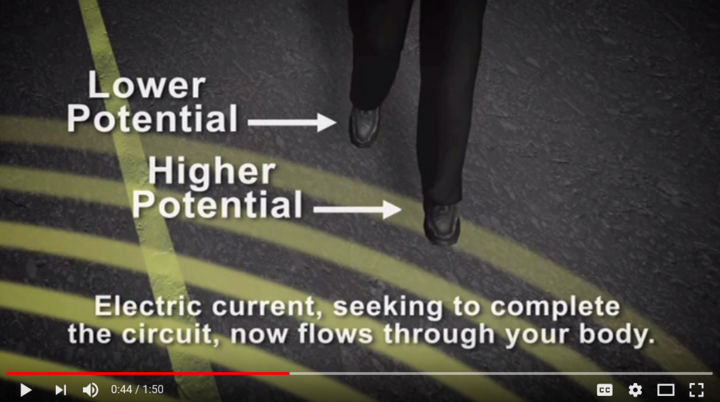The harvest rush means little if it comes at the cost of an injury or even death. Paying attention to surroundings such as power lines can be lifesaving.
Keep any object at least 10 feet away from power lines; the stronger the line, the farther the distance. This fact can get overlooked when activity occurs at the ends of fields, where power lines often are located. Be in the habit of looking up, especially as things get hectic or when helping someone in an unfamiliar field.
When moving equipment, plan a route that avoids overhead power lines or, if they can’t be avoided, lower equipment before reaching them. Always use a spotter to ensure at least 10 feet is maintained between an object and the power lines.
Today’s large equipment, such as loaders, augers and grain trucks, and antennas are at even greater risk of touching or coming dangerously close to power lines. Arcing occurs when electricity “jumps” from power lines to a metal object that touches the ground. If a metal object is wet, the chance of arcing increases.
In October,1993, cotton harvest equipment was parked at the edge of a field, directly under power lines. Wet cotton was stuck to a raised harvest basket that was dumping into a cotton baler. As the operator began climbing into the basket to dislodge the cotton, 14,000 volts of electricity from the power line arced into the wet basket, electrocuting the operator.
An Illinois farmer, 4-H leader and master livestock showman was operating a crop sprayer in March 1991. The sprayer became entangled with an overhead electric wire; when the farmer climbed out of the cab and stepped down from the metal ladder, he was electrocuted and later died.
In both incidents, the victims reportedly were familiar with safety training, though were helping others so weren’t on their own familiar property.
Even in familiar surroundings wind, uneven ground, shifting weight, and other conditions can cause a dangerous situation, causing equipment to move closer to lines than you had expected.
Know where fuse boxes and circuit breakers are located and ensure others know their locations and can shut them off in an emergency.
More Information
 This 2-minute video, presented by Northeast Utilities, illustrates the danger in step potential — walking into a power-charged area near a downed line.
This 2-minute video, presented by Northeast Utilities, illustrates the danger in step potential — walking into a power-charged area near a downed line.

For more on power line safety, also check out these videos:
- Nebraska Public Power District — Spring Farm Safety, Nebraska farmer Larry Mohrman with safety tips for his fellow farmers
For more information on agricultural safety topics, visit the Central States Center for Agricultural Safety and Health (University of Nebraska Medical Center) or contact Aaron Yoder, assistant professor, Environment, Agricultural and Occupational Health, University of Nebraska Medical Center, 402-552-7240, aaron.yoder@unmc.edu.
Resources for this story and additional information are:
If you hit a power line ...
and there is not a fire:
- Stay in your vehicle. The ground may be electrified.
- Call 911 and/or the power company. If you do not have a phone, stay with the vehicle. The power company will be out to check on the power disruption.
- Do no try to pull the equipment away from the power lines or poles. This will cause more damage to the line.


Source: Nebraska Public Power District (NPPD)
Even rubber tires may not provide insulation because they contain steel and carbon black, both of which conduct electricity.
and there is a fire:
You must quickly—but safely— escape the vehicle or rig. Do not allow any part of your body to touch equipment and ground at the same time.
- Stay seated and open the door completely, looking around to make sure no wires are exposed.
- Stand in the door frame with feet together and arms crossed.
- As carefully as you can, jump from the vehicle as far as possible, keeping arms crossed and feet together. Never touch the ground and vehicle together at the same time, as electricity can flow through you from the rig to the ground.
- Keep your feet together. Separating your feet allows electricity to flow from one foot through your body to the other foot, causing serious injury or even death.
- Hop at least 33 feet (approximately 33 hops) from the site of the accident, then slowly slide your feet apart. If you feel tingling, continue to hop farther away until you are safe. If you cannot hop, shuffle your feet slowly, keeping both feet on the ground at all times. Voltage diminishes the farther out it is from the source.
- Call 911 and/or the power company.
Once away from the vehicle or equipment, never attempt to get back on or even touch it. Electrocutions have occurred when the operator dismounts, and realizing nothing has happened, tries to get back on the equipment.
If lines are down, do not touch anything touching the downed line, especially anything metal. Nonmetal objects such as soil, branches, even straw, also can become energized.

